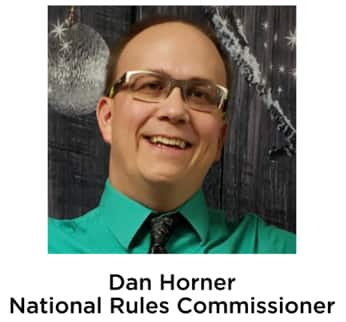
Rules Rule! February 2023
by Dan Horner, National Rules Commissioner

National Rules Commissioner Dan Horner welcomes questions from members and will respond timely along with occasionally featuring a few each month in USAR’s Serving Up the News. Write to Dan at rulescommissioner@usaracquetball.com, and you may see your questions in a future issue of this newsletter!
Q1. My long term opponent sometimes uses his hand to touch me on the back during rallies, he said in an effort to not run into me. However that normally "freezes" my play for a second, so I have less time to return the shot. Do the rules allow using your opponent as a prop?
A1. There is no rule prohibiting touching your opponent, however Rule 3.15(e) states that if your opponent deliberately pushes or shoves you during a rally that he/she earns a penalty hinder and thus loses the rally instantly at the time of the infraction. The only time your opponent should use his hand and reach out and touch you is if you are really close to him and he feels one of you might get hurt...but he can't push off of you. Most likely when this occurs, if you don't move immediately after he touches you, then you should lose the rally because of Failure to Move or Blocking rules 3.15(a) or (c). Remember, the defensive players have one job and that is to get out of the way so that the offensive players can go wherever they want to get to the ball. If your opponent is touching you, it should never be right before or during your shot, but only right before their shot. If they are touching you for no reason when it is your shot, they could be called for a Penalty Hinder for an intentional distraction as described in Rule 3.15(f).
Q2. At a recent tournament, a player lost their safety glasses during a rally, NOT due to their opponent knocking them off. The player actually caught them and was able to put them back on and played the rally out. Some spectators said that since the glasses didn't hit the floor, it was okay for the rally to continue. Should the rally have been stopped once they came off and been considered a penalty hinder?
A2. This is a great question that is not directly addressed in the Rulebook in the manner you presented. My call would be Penalty Hinder and immediate loss of rally per Rule 3.15(i).
Rule 3.15(i) states: "Apparel or Equipment Loss. If a player loses (becomes fully dislodged from their person) any apparel, equipment, or other article they brought onto the court, play shall be immediately stopped and that player shall be assessed a penalty hinder, unless the last shot that was hit could not be retrieved. Note, that if the loss of equipment is caused by a player's opponent, then a replay hinder should be called instead. If the opponent's action is judged to have been avoidable, then the opponent should be called for a penalty hinder."
NOTE—the rule doesn't state that the eye wear (aka safety glasses/goggles) have to hit the floor; it simply states that the eye wear must become fully dislodged from the player, which in your question they do.
The other rules related to eye wear are Rule 2.5(a), 2.5(d), and 3.17(a)(9), however those are written with the thought that the player began the rally or warm-up period without eye wear on at all.
Q3. I was refereeing a match and want to explain a call I made, to see if I did so correctly. The server hit a drive serve down the left side of the court a few feet to the left of their body. Her opponent anticipated it was going right, so she broke to the right; however, she was incorrect on where it was going. The receiver put up their off-hand seeking a screen serve call, although she had taken herself out of the play by their own actions. I went ahead and gave her the screen call she wanted, but later second guessed myself, so I wanted to ask you what the right call was.
A3. From what you described, this was not the correct call. There are three pieces that have to be met on all screens whether on the serve or during the rally and they are:
- The ball has to have passed so closely to the player (or his/her partner in doubles) who hit the ball that it prevents the receiver from having a clear view of the ball.
- The receiver has to be in a good court position near center court to obtain that view.
- The receiver has to have been negatively impacted by the potential screen.
If the receiver incorrectly anticipated what direction the ball was going to go, then went in the wrong direction, and from their new vantage point was not able to clearly see the ball, it would not be a screen. If she had followed #2 above, she would have had a clear view of the serve, thus it is not a screen serve.
The USA Racquetball Official Rules of Racquetball can be downloaded or viewed online on the USA Racquetball website: https://www.teamusa.org/usa-racquetball/rules.